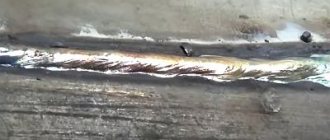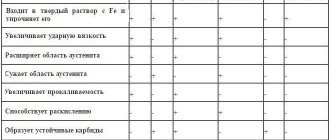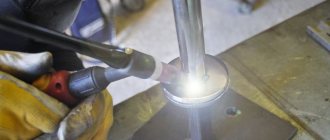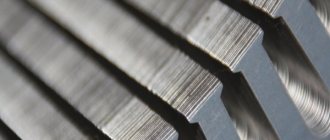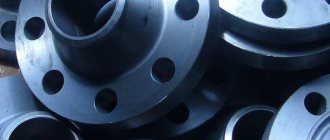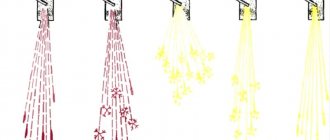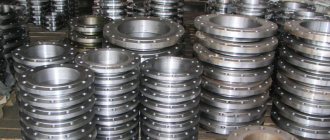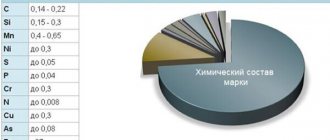Main characteristics
When considering AISI 321 alloy, the technical characteristics of which determine its distribution in a wide variety of industries, the following qualities should be taken into account:
- Heat resistance and heat resistance. These features of steel allow it to be used in the manufacture of critical products. Friction and operation in difficult conditions lead to heating of the structure, due to which the main operational characteristics are reduced. Heat resistance and heat resistance determine that the structure is more resistant to heat. The resulting products can be operated at temperatures from 600 to 800 degrees Celsius. At the same time, the product can withstand prolonged exposure to high temperatures, maintaining its quality.
- The inclusion of titanium in the composition has significantly increased the resistance to intercrystalline corrosion. AISI 321, an analogue of which has similar performance qualities, becomes a more expensive material due to the addition of titanium.
Physical properties of AISI 321
Despite the high corrosion cost due to the inclusion of large amounts of chromium and nickel, AISI 321 is not recommended for use in highly oxidizing environments.
The Russian analogue of this steel is 08Х18Н10Т.
Story
In 1820–1821, Michael Faraday and Pierre Berthier noted the ability of a chromium-iron alloy to resist acid corrosion. Since scientists did not yet know the role of low carbon content, they were unable to obtain an alloy with a high chromium content[4].
Stainless steel was patented in 1912 by German engineers Krupp. The patent concerned austenitic steel. The name stainless steel was first used by the English engineer Harry Brearley. He worked in the arms industry at Brown Firth Laboratories in Sheffield. In 1913, Harry Brearley, experimenting with various types and properties of alloys, discovered the ability of steel with a high chromium content to resist acid corrosion.
The Englishman managed to convince knife manufacturer R. F. Mosley of his new invention. Initially, stainless steel was used only for making cutlery. In 1924, Great Britain patented AISI 304 steel containing 18% chromium and 8% nickel.
Chemical composition
AISI 321 stainless steel has a special chemical composition, which determines the main performance characteristics. Essential elements:
- The main chemical element is considered to be carbon. In the case under consideration, its concentration is 0.08%. A small amount of this element in the composition ensures good weldability of AISI 321 and plasticity of the structure.
- Chromium is responsible for corrosion resistance. To increase the protection of the structure from exposure to high moisture and some other substances, the concentration is maintained within the range of 17 to 19%.
- Nickel is also included in the alloy in high concentration, about 12%. Due to this, the resulting products become ductile and more durable.
- Manganese is included in the AISi structure, the concentration is no more than 2%. Most stainless steels have it.
- As previously noted, during the manufacture of the alloy, titanium is also added, which significantly expands the scope of its application. However, the process of introducing this element is characterized by high complexity, which leads to an increase in the cost of the metal.
Rolled metal AISI 321
The chemical composition of AISI 321 steel is determined by the fact that the material does not have magnetic properties, but the surface is not resistant to oxidation. The compositional features complicate the hardening process.
Welding of stainless steels
| This section is missing references to information sources. Information must be verifiable, otherwise it may be questioned and deleted. You may edit this article to include links to authoritative sources. This mark was set on December 22, 2015 . |
Welding of stainless steels has features characteristic of all high-alloy steels. First of all, when welding, it is necessary to take into account and prevent the burning out of various elements and, in connection with this, a change in the chemical composition of the seam, the danger of overheating of the welding site, which arises due to low thermal conductivity (up to 50% of conventional steels) and the high electrical resistivity of the metal being welded , as well as significant thermal deformations caused by a higher coefficient of thermal expansion.
Electric welding of stainless steels can be carried out using resistance welding and various arc welding methods. The manual method often uses argon-arc welding with a non-consumable tungsten electrode with manual supply of filler wire, semi-automatic welding with a consumable electrode in a shielding gas, as well as welding with piece (coated) electrodes. In automatic welding, the technologies are similar to semi-automatic welding. Carbon dioxide can be used as a protective medium when welding low-critical parts with a carbon or consumable electrode; when welding critical parts, inert gases argon or helium, as well as gas mixtures, can be used. Welding with a tungsten electrode in a carbon dioxide environment is only possible when using a double nozzle with an internal argon jet protecting the electrode. To remove the oxide film and improve the quality of the seam, fluxes are used.
Gas oxygen-acetylene welding is also possible, but is now practically not used, although for a long time it was the only way to weld thin-walled stainless steel parts. Currently, when welding thin metals, the pulsed electric welding mode is common, in which welding current pulses with a frequency of 2..3 Hz are superimposed on a constant (“standby”) arc current of 5..10 A. The magnitude of the welding current in the pulse is adjustable within a wide range of 10...200 A.[8]
Austenitic stainless steels like 12Х18Н9, 12Х18Н10 [approx. 1] (approximately of these are used to roll stainless steel sheets) do not tolerate calcination. Calcination causes structural changes in them, due to which, after calcination, intergranular (intercrystalline) corrosion will begin in the steel. Intergranular corrosion is also dangerous because it does not cause loss of the product’s presentation, so that the product, while still beautiful and shiny, can suddenly collapse under load.
To protect against intergranular corrosion, titanium (T) or niobium (B) is added to such steels in an amount of 5 - 0.6%. Steels alloyed in this way are designated: 12Х18Н9 Т
, 12Х18Н9
B
, 12Х18Н10
Т
, 12Х18Н10
B
[approx. 2]. Accordingly, austenitic stainless steels suitable for welding (if without subsequent heat treatment) are those with the letter “T” or “B” at the end.
Piece (coated [note 3]) welding electrodes are produced not only from black steel (for welding black steels), but also from stainless steel (for example, “UONII-13/NZH” [note 4]). The electrical resistance of stainless steel is greater than the electrical resistance of black steel, so welding electrodes made of it are made shorter than electrodes made of black steel, since a stainless electrode that is too long can melt (along its entire length) and collapse before it is completely used up.
To weld a stainless steel part to a black steel part, you need the so-called. transition electrodes. In this case, the steel from which the transition electrodes are made must contain an increased (about one and a half times[note 5]) content of alloying elements (for example, “X25N18...”; “X23N15...”). The transition electrodes have a green coating.
Welding electrodes with a blue coating - for welding food grade stainless steel (tanks, tanks, pipelines, stirrer blades, etc. for the food industry).
Mechanical properties of material 321
AISI 321 stainless steel is characterized by a fairly large number of properties:
- The yield strength is maintained at 205 MPa.
- The minimum tensile strength is not less than 515 MPa.
- The hardness of the material is quite high, the indicator is maintained at the level of 163 HB according to Brinnell.
- When choosing a material, the relative elongation is taken into account. The alloy in question has an indicator of 40%.
- Fatigue strength is about 260 N/mm2.
Strength at elevated temperatures
Quite high mechanical properties determine the wide distribution of the alloy. As previously noted, heat treatment is carried out extremely rarely. This is due to the fact that the workpiece has to be heated to a temperature of more than 1000 degrees Celsius. This requires special equipment, for example, a modern HDTV oven. In some cases, heat treatment is possible, but the process is quite expensive.
Physical properties
The AISI 321 stainless steel in question is used in the manufacture of parts that are subject to mechanical stress and certain chemicals. The main physical properties include the following:
- The density indicator is 7.79 g/cm3. This density is characteristic of many steels.
- The high degree of weldability allows the use of AISI 321 in the manufacture of various welded structures. As previously noted, it is the low carbon concentration that determines good weldability. Welding work can be carried out using various equipment; there is no need to heat the workpiece.
- Good machinability. That is why the supplied workpieces can be subjected to various mechanical processing: turning, milling, drilling and grinding.
Pipeline accessories
The inclusion of titanium in the composition determines a significant increase in the cost of the material. Therefore, it is recommended to use it in the manufacture of critical parts and mechanisms that are operated in difficult conditions.
Areas of use
AISI 321 steel, the use of which is primarily related to heat resistance and corrosion resistance, is considered one of the most common. The characteristics of the chemical composition determine that the alloy is recommended for use in industries where high surface temperatures occur. An example of using stainless steel is:
- Manufacturing of various products for the chemical, petrochemical and textile industries.
- The material is also widely used in medicine and pharmaceuticals.
- Stainless steel is used in the production of welded equipment: pipes, muffles, retors and others.
- In mechanical engineering and aircraft construction, the material is valued due to its corrosion resistance and heat resistance.
- Good heat resistance determines the use of the alloy in the creation of boilers, gas devices, waste collectors and other equipment. Such products must withstand prolonged exposure to heat.
- When creating heat exchangers and various welding equipment. Heat exchangers must quickly transfer heat to the environment.
- When creating structures that are used outdoors or subject to strong heating. Ordinary metals cannot last long when used above the open sky, since precipitation leads to corrosion. Over time, it spoils the decorative qualities of the product and reduces the strength of the structure.
To improve basic performance qualities, various heat treatments can be carried out. An example is annealing, which is carried out at a temperature of about 1000 degrees Celsius. Tempering is carried out at a temperature of 800 degrees Celsius, hot processing is performed, for which the material is heated to 1300 degrees Celsius.
Welded pipes made from stainless steel sheets have become widespread. The use of modern technologies makes it possible to increase the rigidity and strength of the resulting products. It is supplied to production lines in the form of sheet steel or rolled steel, as well as rods.
Production and Application
According to the International Stainless Steel Forum, the global production of stainless steel in 2009 amounted to 24.579 million tons[7]
Five kopecks of Ukraine, 1992, stainless steel
- Chromium stainless steels: Hydraulic press valves;
- Turbine blades;
- Cracking plant fittings;
- Cutting tool;
- Springs;
- Household items;
- Household items, in particular tableware (food grade steel)
- Welding equipment operating in aggressive environments;
Stainless steels are used in both wrought and cast states.

